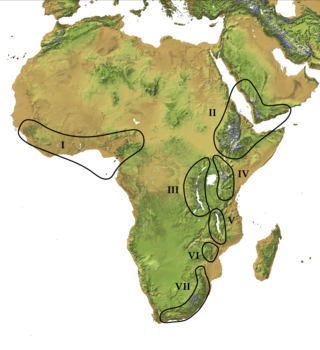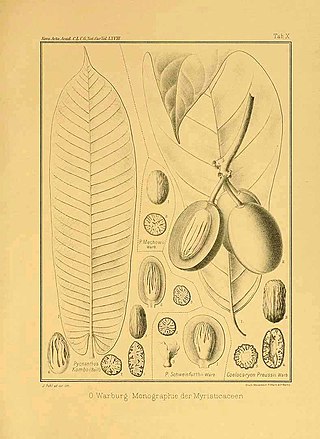
Ricinodendron is a plant genus in the family Euphorbiaceae first described as a genus in 1864. It includes only one known species, Ricinodendron heudelotii, native to tropical Africa from Senegal + Liberia east to Sudan and Tanzania and south to Mozambique and Angola. It produces an economically important oilseed. The tree is known as munguella (Angola), njangsa (Cameroon), bofeko, wama (Ghana), okhuen (Nigeria), kishongo (Uganda), akpi, djansang, essang, ezezang and njasang. Two varieties of the tree species are recognized R. heudelotii var. heudelotii in Ghana and R. heudelotii var. africanum in Nigeria and westwards.

Grevillea robusta, commonly known as the southern silky oak, silk oak or silky oak, silver oak or Australian silver oak, is a flowering plant in the family Proteaceae, and accordingly unrelated to true oaks, family Fagaceae. Grevillea robusta is a tree, and is the largest species in its genus. It is a native of eastern coastal Australia, growing in riverine, subtropical and dry rainforest environments.

Irvingia gabonensis is a species of African trees in the genus Irvingia, sometimes known by the common names wild mango, African mango, or bush mango. They bear edible mango-like fruits, and are especially valued for their fat- and protein-rich nuts.

The Afromontane regions are subregions of the Afrotropical realm, one of the Earth's eight biogeographic realms, covering the plant and animal species found in the mountains of Africa and the southern Arabian Peninsula. The Afromontane regions of Africa are discontinuous, separated from each other by lower-lying areas, and are sometimes referred to as the Afromontane archipelago, as their distribution is analogous to a series of sky islands.

Podocarpus milanjianus is a species of conifer in the family Podocarpaceae. It is native to the highlands and mountains of tropical Africa.
Afromorus mesozygia, known as black mulberry or African mulberry, is the only species in the genus Afromorus. The plant is a small- to medium-sized forest tree of Tropical Africa. Its leaves and fruit provide food for the mantled guereza, a colobus monkey native to much of Tropical Africa, and for the common chimpanzee of West and Central Africa. It is also a commercial hardwood.

Antiaris toxicaria is a tree in the mulberry and fig family, Moraceae. It is the only species currently recognized in the genus Antiaris. The genus Antiaris was at one time considered to consist of several species, but is now regarded as just one variable species which can be further divided into five subspecies. One significant difference within the species is that the size of the fruit decreases as one travels from Africa to Polynesia. Antiaris has a remarkably wide distribution in tropical regions, occurring in Australia, tropical Asia, tropical Africa, Indonesia, the Philippines, Tonga, and various other tropical islands. Its seeds are spread by various birds and bats, and it is not clear how many of the populations are essentially invasive. The species is of interest as a source of wood, bark cloth, and pharmacological or toxic substances.

Gliricidia sepium, often simply referred to as gliricidia or by its Spanish common name madre de cacao, is a medium size leguminous tree belonging to the family Fabaceae. It is an important multi-purpose legume tree, with a native range from Mexico to Colombia, but now widely introduced to other tropical zones.

Pycnanthus angolensis is a species of tree in the nutmeg family, Myristicaceae. It is native to Tropical Africa. Its English language common names include African nutmeg, false nutmeg, boxboard, and cardboard. In Africa it is widely known as ilomba.

Maesopsis eminii, the umbrella tree, is a species of tree in the family Rhamnaceae found in India and Africa. It is the only species in the genus Maesopsis. It is often grown as a plantation tree, and as a shade tree in coffee plantations and other crops. Birds and monkeys may disperse the seeds. Since this tree grows fast it is often used for regeneration of destroyed forest lands. Its timber is used for construction and firewood and its leaves for animal fodder.

Strombosia is a plant genus of about 10 species in the family Olacaceae. It has also been classified in the family Strombosiaceae. The generic name is from the Greek strombos, meaning "pear-shaped", referring to the fruit.

Strombosia pustulata is a species of tree in the family Olacaceae. It is native to the rainforests of tropical West and Central Africa. Common names for this tree include itako in Nigeria, afina in Ghana, poé in Abé spoken in Côte d'Ivoire and mba esogo in Equatorial Guinea.
Newtonia buchananii is a species of plant in the family Fabaceae.
Aningeria adolfi-friederici is a species of plant in the family Sapotaceae, a tall, tropical forest tree. It is found in Burundi, the Democratic Republic of the Congo, Ethiopia, Kenya, Malawi, Rwanda, Sudan, Tanzania, Uganda, Zambia and Zimbabwe. The specific name adolfi-friedericii was given in honour of Duke Adolf Friedrich of Mecklenburg, a German explorer in Africa. Its trade name muna is taken from Gĩkũyũ mũna.

The Victoria Basin forest–grassland mosaic is an ecoregion that lies mostly in Uganda and extends into neighboring countries. The ecoregion is centered north and west of Lake Victoria, with an outlier on the border of Ethiopia and South Sudan.
Drypetes gerrardii is a species of small tree or large shrub in the family Putranjivaceae. Common names include forest ironplum, bastard white ironwood, and forest ironwood. It is native to tropical and subtropical central and eastern Africa. It was first described in 1920 by the English botanist John Hutchinson, who named it after the English botanist William Tyrer Gerrard who collected plants and seeds in southern Africa in the 1860s.
Ongokea is a genus of flowering plants, with one species Ongokea gore (Boleko). In the APG IV system, the genus is placed in the family Olacaceae. Other sources place it in the segregate family Aptandraceae.
Gambeya africana is a medium sized tree within the Sapotaceae family. It is sometimes known as the African Star Apple along with the closely related Gambeya albida. Both species have similar leaf indumentum and are widespread in the Lower and Upper Guinea forest mosaic.
Albizia zygia is a fast growing medium-sized tree species within the Fabaceae family that is commonly found in West and Central Africa.
Ixora scheffleri is small to medium-sized tree species within the family Rubiaceae. It is among four Ixora species occurring in Africa than has a predominant tree habit. It has two infraspecifics, one of which is endangered, the Ixora scheffleri subsp. keniensis.











